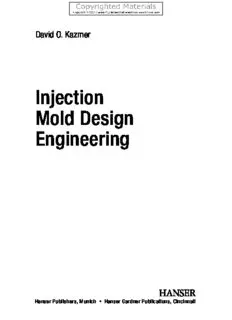Table Of ContentDavid O. Kazmer
Injection
Mold Design
Engineering
Hanser Publishers, Munich • Hanser Gardner Publications, Cincinnati
TheAuthor:
DavidO.Kazmer,P.E.,Ph.D.DepartmentofPlasticsEngineering,1UniversityAvenue,Lowell,MA01854,USA
DistributedintheUSAandinCanadaby
HanserGardnerPublications,Inc.
6915ValleyAvenue,Cincinnati,Ohio45244-3029,USA
Fax:(513)527-8801
Phone:(513)527-8977or1-800-950-8977
www.hansergardner.com
Distributedinallothercountriesby
CarlHanserVerlag
Postfach860420,81631München,Germany
Fax:+49(89)984809
www.hanser.de
Youruseoftheinformationprovidedhereinisconditioneduponyouragreement,andtheagreementofyouremployeror
anythirdpartytowhomyouprovideinformation,tomakeuseofthesematerialsonlyinaccordancewithandsubjectto
thefollowingtermsandconditions.
Theinformationprovidedhereinismadeavailable“asis”withoutwarrantyofanykind,eitherexpressorimplied,including
butnotlimitedtotheimpliedwarrantiesofmerchantability,fitnessforaparticularpurpose,satisfactoryquality,ornon-
infringement.Wemayinthefuturemodify,improveormakeotherchangestotheinformationmadeavailable.Allthe
includedinformationmayincludetechnicalortypographicalerrorsandwewillnotberesponsibleforanysucherrors.
Anypricingandotherinformationaboutproductsandservicescontainedhereinisnotanoffertoprovidesuchgoodsor
services.
Youagreenottobringanylegalactionagainsttheauthororpublisherbasedonyouruseoftheprovidedinformation.You
agreetoindemnifyandholdthecopyrightholderanditsaffiliates,officers,agents,andemployeesharmlessfromanyclaim
ordemand,includingreasonableattorneys‘fees,madebyanythirdpartyduetoorarisingoutofyouruseoftheprovided
information.Thesoleandmaximumliabilityofthecopyrightholder,itsaffiliatesandsubsidiariesforanyreason,andyour
exclusiveremedyforanycausewhatsoever,shallbelimitedtotheamountpaid,ifany,fortheprovidedinformation.
LibraryofCongressCataloging-in-PublicationData
Kazmer,David.
Injectionmolddesignengineering/DavidO.Kazmer.
p.cm.
ISBN-13:978-1-56990-417-6(hardcover)
ISBN-10:1-56990-417-0(hardcover)
1. Injectionmoldingofplastics. I.Title.
TP1150.K392007
668.4‘12--dc22
2007018765
BibliografischeInformationDerDeutschenBibliothek
DieDeutscheBibliothekverzeichnetdiesePublikationinderDeutschenNationalbibliografie;
detailliertebibliografischeDatensindimInternetüber<http://dnb.d-nb.de>abrufbar.
ISBN978-3-446-41266-8
Allrightsreserved.Nopartofthisbookmaybereproducedortransmittedinanyformorbyanymeans,electronicor
mechanical,includingphotocopyingorbyanyinformationstorageandretrievalsystem,withoutpermissioninwirting
fromthepublisher.
©CarlHanserVerlag,Munich2007
ProductionManagement:OswaldImmel
TypesetbyManuelaTreindl,Laaber,Germany
Coverconcept:MarcMüller-Bremer,Rebranding,München,Germany
CoverillustrationbyDavidO.Kazmer,Lowell,USA
Coverdesign:MCP•SusanneKrausGbR,Holzkirchen,Germany
PrintedandboundbyDruckhaus“ThomasMüntzer”GmbH,BadLangensalza,Germany
Preface
Molddesignhasbeenmoreofatechnicaltradethananengineeringprocess.Traditionally,
practitioners have shared standard practices and learned tricks of the trade to develop
sophisticatedmoldsthatoftenexceedcustomerexpectations.
However,thelackoffundamentalengineeringanalysisduringmolddesignfrequentlyresults
inmoldsthatmayfailandrequireextensiverework,producemoldingsof inferiorquality,
orarelesscosteffectivethanmayhavebeenpossible.Indeed,ithasbeenestimatedthaton
average49outof 50moldsrequiresomemodificationsduringthemoldstart-upprocess.
Manytimes,molddesignersandend-usersmaynotknowhowmuchmoneywas“lefton
thetable”.
Theword“engineering”inthetitleofthisbookimpliesamethodicalandanalyticalapproachto
molddesign.Theengineerwhounderstandsthecausalitybetweendesigndecisionsandmold
performancehastheabilitytomakebetterandmoreinformeddecisionsonanapplicationby
applicationbasis.Suchdecisionmakingcompetenceisacompetitiveenablerbysupporting
the development of custom mold designs that outperform molds developed according to
standardpractices.Theproficientengineeralsoavoidsthecostandtimeneededtodelegate
decisiontootherparties,whoarenotnecessarilymorecompetent.
Thebookhasbeenwrittenasateachingtext,butisgearedtowardsprofessionalsworkingin
atightlyintegratedsupplychainincludingproductdesigners,molddesigners,andinjection
molders. Compared to most handbooks, this textbook provides worked examples with
rigorousanalysisanddetaileddiscussionof vitalmoldengineeringconcepts.Itshouldbe
understoodthatthistextbookpurposefullyinvestigatestheprevalentandfundamentalaspects
ofinjectionmoldengineering.
I hope that Injection Mold Design Engineering is accessible and useful to all who read it.I
welcomeyourfeedbackandpartnershipforfutureimprovements.
Bestwishes,
DavidKazmer,P.E.,Ph.D.
Lowell,Massachusetts
June1,2007
Contents
Preface......................................................................... V
Nomenclature................................................................. XV
1 Introduction ................................................................ 1
1.1 OverviewoftheInjectionMoldingProcess................................ 1
1.2 MoldFunctions ........................................................ 3
1.3 MoldStructures........................................................ 4
1.3.1 ExternalViewofMold ........................................... 4
1.3.2 ViewofMoldduringPartEjection ................................ 6
1.3.3 MoldSectionandFunction....................................... 7
1.4 OtherCommonMoldTypes............................................. 9
1.4.1 ThreePlate,Multi-CavityFamilyMold............................. 9
1.4.2 HotRunner,Multi-Gated,SingleCavityMold ..................... 11
1.4.3 Comparison ................................................... 12
1.5 TheMoldDevelopmentProcess......................................... 13
1.6 ChapterReview ....................................................... 15
2 PlasticPartDesign.......................................................... 17
2.1 TheProductDevelopmentProcess ...................................... 17
2.1.1 ProductDefinition.............................................. 18
2.1.2 ProductDesign................................................. 18
2.1.3 BusinessandProductionDevelopment ........................... 19
2.1.4 Scale-UpandLaunch ........................................... 19
2.1.5 RoleofMoldDesign............................................ 19
2.2 DesignRequirements .................................................. 20
2.2.1 ApplicationEngineeringInformation............................. 20
2.2.2 ProductionData................................................ 21
2.2.3 EndUseRequirements.......................................... 22
2.2.4 ProductDesignMethodology.................................... 24
2.2.5 PlasticMaterialProperties....................................... 26
2.3 DesignforInjectionMolding ........................................... 28
2.3.1 UniformWallThickness......................................... 28
2.3.2 RibDesign..................................................... 29
2.3.3 BossDesign.................................................... 29
2.3.4 CornerDesign ................................................. 30
2.3.5 SurfaceFinishandTextures...................................... 31
2.3.6 Draft.......................................................... 33
2.3.7 Undercuts ..................................................... 34
2.4 ChapterReview ....................................................... 35
VIII Contents
3 MoldCostEstimation....................................................... 37
3.1 TheMoldQuotingProcess ............................................. 37
3.2 CostDriversforMoldedParts........................................... 39
3.2.1 EffectofProductionQuantity.................................... 40
3.2.2 Break-EvenAnalysis ............................................ 41
3.3 MoldCostEstimation.................................................. 43
3.3.1 CavityCostEstimation.......................................... 44
3.3.1.1 CavitySetCost ......................................... 45
3.3.1.2 CavityMaterialsCost.................................... 45
3.3.1.3 CavityMachiningCost.................................. 46
3.3.1.4 CavityDiscountFactor.................................. 51
3.3.1.5 CavityFinishingCost ................................... 51
3.3.2 MoldBaseCostEstimation...................................... 53
3.3.3 MoldCustomization............................................ 55
3.4 PartCostEstimation................................................... 60
3.4.1 MoldCostperPart ............................................. 60
3.4.2 MaterialCostperPart........................................... 61
3.4.3 ProcessingCostperPart......................................... 62
3.4.4 DefectCostperPart ............................................ 65
3.5 ChapterReview ....................................................... 66
4 MoldLayoutDesign......................................................... 67
4.1 PartingPlaneDesign................................................... 67
4.1.1 DetermineMoldOpeningDirection.............................. 67
4.1.2 DeterminePartingLine ......................................... 70
4.1.3 PartingPlane................................................... 71
4.1.4 Shut-Offs...................................................... 73
4.2 CavityandCoreInsertCreation......................................... 74
4.2.1 HeightDimension.............................................. 74
4.2.2 LengthandWidthDimensions................................... 75
4.2.3 Adjustments ................................................... 76
4.3 MoldBaseSelection.................................................... 77
4.3.1 CavityLayouts ................................................. 77
4.3.2 MoldBaseSizing ............................................... 79
4.3.3 MoldingMachineCompatibility ................................. 81
4.3.4 MoldBaseSuppliers ............................................ 83
4.4 MoldMaterialSelection................................................ 84
4.4.1 Strengthvs.HeatTransfer ....................................... 84
4.4.2 Hardnessvs.Machinability ...................................... 85
4.4.3 Mold-Maker’sCostvs.Molder’sCost ............................. 86
4.4.4 MaterialSummary.............................................. 88
4.5 ChapterReview ....................................................... 89
Contents IX
5 CavityFillingAnalysisandDesign ........................................... 91
5.1 Overview............................................................. 91
5.2 ObjectivesinCavityFilling ............................................. 92
5.2.1 CompleteFillingofMoldCavities................................ 92
5.2.2 AvoidUnevenFillingorOver-Packing ............................ 92
5.2.3 ControltheMeltFlow........................................... 93
5.3 ViscousFlow.......................................................... 94
5.3.1 ShearStress,ShearRate,andViscosity ............................ 94
5.3.2 PressureDrop.................................................. 95
5.3.3 RheologicalBehavior ........................................... 96
5.3.4 NewtonianModel .............................................. 98
5.3.5 PowerLawModel............................................... 99
5.4 Validation ...........................................................102
5.5 CavityFillingAnalysesandDesigns.....................................104
5.5.1 EstimatingtheProcessingConditions............................104
5.5.2 EstimatingtheFillingPressureandMinimumWallThickness......107
5.5.3 EstimatingClampTonnage.....................................109
5.5.4 PredictingFillingPatterns......................................112
5.5.5 DesigningFlowLeaders........................................114
5.6 ChapterReview ......................................................117
6 FeedSystemDesign........................................................119
6.1 Overview............................................................119
6.2 ObjectivesinFeedSystemDesign.......................................119
6.2.1 ConveyingthePolymerMeltfromMachinetoCavities ............119
6.2.2 ImposeMinimalPressureDrop.................................120
6.2.3 ConsumeMinimalMaterial ....................................121
6.2.4 ControlFlowRates ............................................122
6.3 FeedSystemTypes....................................................123
6.3.1 Two-PlateMold...............................................123
6.3.2 Three-PlateMold..............................................125
6.3.3 HotRunnerMolds.............................................130
6.4 FeedSystemAnalysis..................................................132
6.4.1 DetermineTypeofFeedSystem.................................133
6.4.2 DetermineFeedSystemLayout..................................134
6.4.3 EstimatePressureDrops........................................138
6.4.4 CalculateRunnerVolume ......................................140
6.4.5 OptimizeRunnerDiameters....................................141
6.4.6 BalanceFlowRates ............................................145
6.4.7 EstimateRunnerCoolingTimes.................................148
6.4.8 EstimateResidenceTime.......................................149
6.5 PracticalIssues.......................................................150
6.5.1 RunnerCross-Sections.........................................150
6.5.2 SuckerPins ...................................................154
X Contents
6.5.3 RunnerShut-Offs..............................................155
6.5.4 StandardRunnerSizes .........................................157
6.5.5 SteelSafeDesigns..............................................157
6.6 ChapterReview ......................................................158
7 GatingDesign.............................................................161
7.1 ObjectivesofGatingDesign ...........................................161
7.1.1 ConnectingtheRunnertotheMoldCavity.......................161
7.1.2 ProvideAutomaticDe-Gating...................................161
7.1.3 ProvideAestheticDe-Gating....................................162
7.1.4 AvoidExcessiveShearorPressureDrop..........................162
7.1.5 ControlPackTimes............................................163
7.2 CommonGateDesigns................................................163
7.2.1 SprueGate....................................................163
7.2.2 Pin-PointGate................................................164
7.2.3 EdgeGate.....................................................165
7.2.4 TabGate......................................................166
7.2.5 FanGate......................................................167
7.2.6 Flash/DiaphragmGate.........................................168
7.2.7 Tunnel/SubmarineGate........................................169
7.2.8 ThermalGate.................................................172
7.2.9 ValveGate ....................................................174
7.3 TheGatingDesignProcess.............................................175
7.3.1 DetermineTypeofGate........................................175
7.3.2 CalculateShearRates ..........................................176
7.3.3 CalculatePressureDrop........................................178
7.3.4 CalculateGateFreezeTime.....................................179
7.3.5 AdjustDimensions ............................................182
7.4 ChapterReview ......................................................182
8 Venting ...................................................................185
8.1 VentingDesignObjectives.............................................185
8.1.1 ReleaseCompressedAir........................................185
8.1.2 ContainPlasticMelt...........................................185
8.1.3 MinimizeMaintenance.........................................186
8.2 VentingAnalysis......................................................186
8.2.1 EstimateAirDisplacementandRate.............................186
8.2.2 IdentifyNumberandLocationofVents..........................186
8.2.3 SpecifyVentDimensions .......................................189
8.3 VentingDesigns......................................................192
8.3.1 VentsonPartingPlane.........................................192
8.3.2 VentsaroundEjectorPins ......................................194
8.3.3 VentsinDeadPockets..........................................196
8.4 ChapterReview ......................................................197
Contents XI
9 CoolingSystemDesign.....................................................199
9.1 ObjectivesinCoolingSystemDesign ...................................199
9.1.1 MaximizeHeatTransferRates...................................199
9.1.2 MaintainUniformWallTemperature ............................199
9.1.3 MinimizeMoldCost...........................................200
9.1.4 MinimizeVolumeandComplexity ..............................200
9.1.5 MinimizeStressandCorrosion .................................200
9.1.6 FacilitateMoldUsage ..........................................201
9.2 TheCoolingSystemDesignProcess.....................................201
9.2.1 CalculatetheRequiredCoolingTime............................201
9.2.2 EvaluateRequiredHeatTransferRate............................206
9.2.3 AssessCoolantFlowRate.......................................208
9.2.4 AssessCoolingLineDiameter...................................209
9.2.5 SelectCoolingLineDepth......................................211
9.2.6 SelectCoolingLinePitch.......................................213
9.2.7 CoolingLineRouting..........................................216
9.3 CoolingSystemDesigns...............................................219
9.3.1 CoolingLineNetworks.........................................219
9.3.2 CoolingInserts................................................222
9.3.3 ConformalCooling............................................222
9.3.4 HighlyConductiveInserts......................................223
9.3.5 CoolingofSlenderCores.......................................224
9.3.5.1 CoolingInsert.........................................225
9.3.5.2 Baffles................................................226
9.3.5.3 Bubblers..............................................227
9.3.5.4 HeatPipes ............................................227
9.3.5.5 ConductivePin........................................229
9.3.5.6 InterlockingCorewithAirChannel......................229
9.3.6 One-SidedHeatFlow ..........................................230
9.4 ChapterReview ......................................................232
10 ShrinkageandWarpage ....................................................233
10.1 TheShrinkageAnalysisProcess.........................................235
10.1.1 EstimateProcessConditions....................................235
10.1.2 ModelCompressibilityBehavior ................................235
10.1.3 AssessVolumetricShrinkage....................................237
10.1.4 EvaluateIsotropicLinearShrinkage .............................241
10.1.5 EvaluateAnisotropicShrinkage .................................242
10.1.6 AssessShrinkageRange ........................................244
10.1.7 EstablishingFinalShrinkageRecommendations ..................245
10.2 ShrinkageAnalysisandValidation......................................247
10.2.1 NumericalSimulation..........................................247
10.2.2 “SteelSafe”MoldDesign .......................................249
10.2.3 ProcessingDependence ........................................249
XII Contents
10.2.4 Semi-CrystallinePlastics .......................................251
10.2.5 EffectofFillers................................................251
10.3 Warpage.............................................................252
10.3.1 SourcesofWarpage............................................252
10.3.2 WarpageAvoidanceStrategies...................................256
10.4 ChapterReview ......................................................257
11 EjectionSystemDesign.....................................................259
11.1 ObjectivesinEjectionSystemDesign ...................................261
11.1.1 AllowMoldtoOpen...........................................261
11.1.2 TransmitEjectionForcestoMoldings............................262
11.1.3 MinimizeDistortionofMoldings ...............................262
11.1.4 ActuateQuicklyandReliably ...................................262
11.1.5 MinimizeCoolingInterference..................................263
11.1.6 MinimizeImpactonPartSurfaces...............................264
11.1.7 MinimizeComplexityandCost.................................264
11.2 TheEjectorSystemDesignProcess .....................................265
11.2.1 IdentifyMoldPartingSurfaces..................................265
11.2.2 EstimateEjectionForces........................................265
11.2.3 DetermineEjectorPushAreaandPerimeter......................269
11.2.4 SpecifyType,Number,andSizeofEjectors.......................271
11.2.5 LayoutEjectors................................................273
11.2.6 DetailEjectorsandRelatedComponents.........................276
11.3 EjectorSystemAnalysesandDesigns....................................278
11.3.1 EjectorPins...................................................278
11.3.2 EjectorBlades.................................................280
11.3.3 EjectorSleeves ................................................282
11.3.4 StripperPlates.................................................283
11.3.5 ElasticDeformationaroundUndercuts ..........................285
11.3.6 CorePulls ....................................................287
11.3.7 Slides.........................................................291
11.3.8 EarlyEjectorReturnSystems....................................294
11.3.9 AdvancedEjectionSystems.....................................296
11.4 ChapterReview ......................................................296
12 StructuralSystemDesign...................................................299
12.1 ObjectivesinStructuralSystemDesign..................................300
12.1.1 MinimizeStress ...............................................300
12.1.2 MinimizeMoldDeflection .....................................304
12.1.3 MinimizeMoldSize ...........................................305
12.2 AnalysisandDesignofPlates ..........................................306
12.2.1 PlateCompression.............................................306
12.2.2 PlateBending.................................................309
12.2.3 SupportPillars................................................312
Contents XIII
12.2.4 ShearStressinSideWalls.......................................317
12.2.5 Interlocks.....................................................319
12.2.6 StressConcentrations..........................................321
12.3 AnalysisandDesignofCores ..........................................325
12.3.1 AxialCompression ............................................326
12.3.2 CompressiveHoopStresses.....................................327
12.3.3 CoreDeflection ...............................................329
12.4 Fasteners ............................................................332
12.4.1 Fits ..........................................................332
12.4.2 SocketHeadCapScrews........................................336
12.4.3 Dowels.......................................................338
12.5 Review ..............................................................340
13 MoldTechnologies.........................................................343
13.1 Introduction.........................................................343
13.2 CoinjectionMolds....................................................343
13.2.1 CoinjectionProcess............................................345
13.2.2 CoinjectionMoldDesign.......................................346
13.2.3 GasAssist/WaterAssistMolding.................................347
13.3 InsertMolds .........................................................350
13.3.1 LowPressureCompressionMolding.............................350
13.3.2 InsertMoldwithWallTemperatureControl......................351
13.3.3 LostCoreMolding.............................................353
13.4 InjectionBlowMolds .................................................355
13.4.1 InjectionBlowMolding........................................355
13.4.2 MultilayerInjectionBlowMolding ..............................357
13.5 Multi-ShotMolds.....................................................358
13.5.1 Overmolding..................................................359
13.5.2 Core-BackMolding............................................360
13.5.3 Multi-StationMold............................................362
13.6 FeedSystems.........................................................364
13.6.1 InsulatedRunner..............................................364
13.6.2 StackMolds...................................................365
13.6.3 BranchedRunners.............................................368
13.6.4 DynamicMeltControl.........................................369
13.7 MoldWallTemperatureControl........................................372
13.7.1 PulsedCooling................................................372
13.7.2 ConductionHeating...........................................373
13.7.3 InductionHeating.............................................375
13.7.4 ManagedHeatTransfer ........................................377
13.8 In-MoldLabeling.....................................................378
13.8.1 StaticallyChargedFilm.........................................379
13.8.2 IndexedFilm..................................................380
13.9 Ejection .............................................................381

